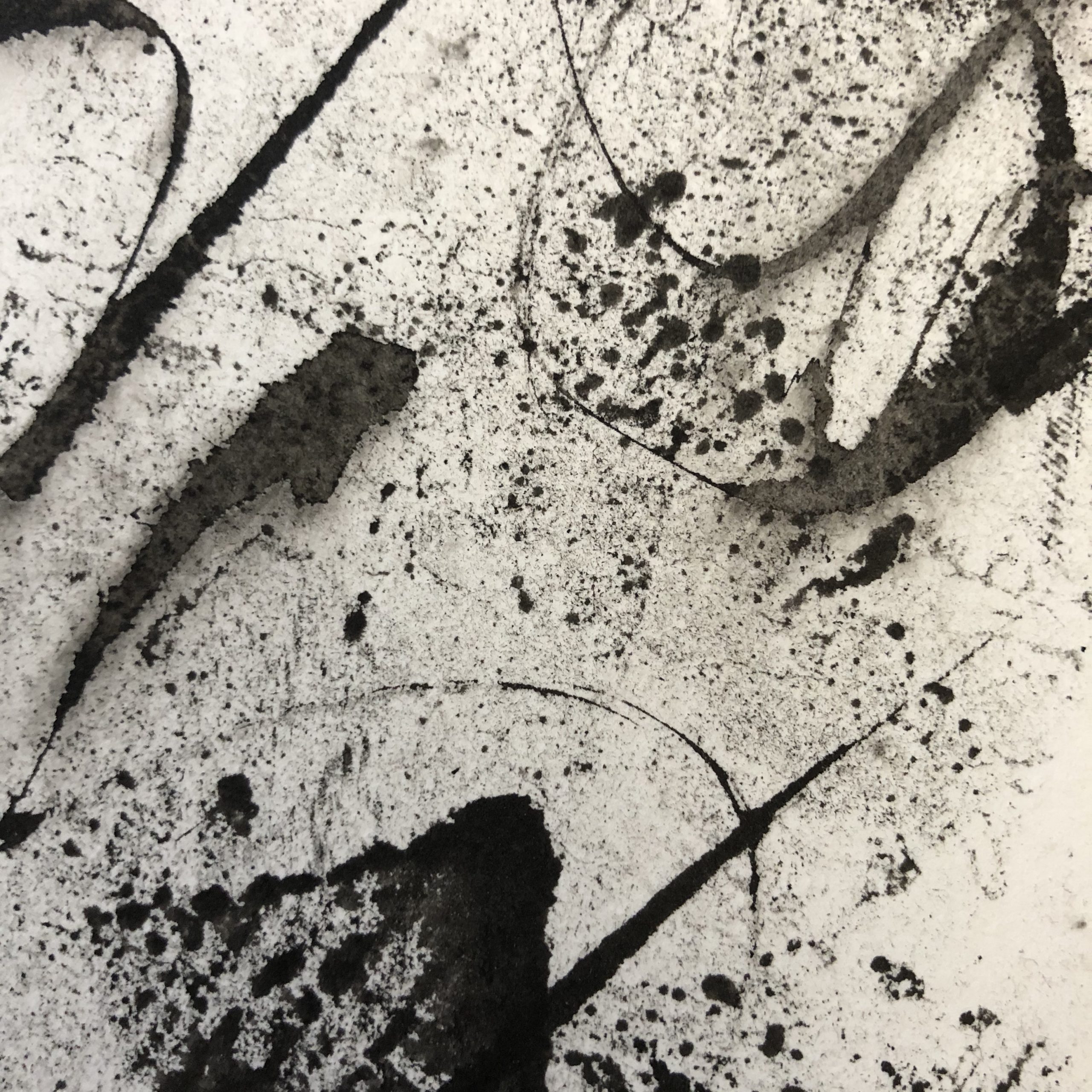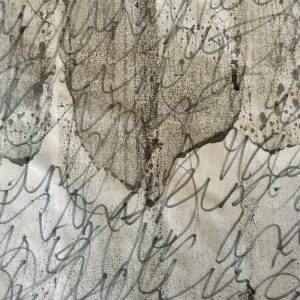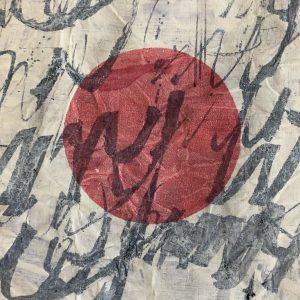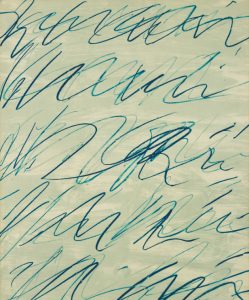
B Buckles – sumi ink on watercolor paper – 2020
Please indulge me as I take the liberty of going off on a tangent here.
But I don’t want cursive to die. Because from one hand to the next, it’s such a distinctive expression of who each of us is.
I love sifting through the bin in my storage shed that’s filled with cards and letters I’ve received over my lifetime — some from people who are still living, others from people who are not — and recognizing the unique script of someone I’ve known. Just seeing their handwriting brings my memory of them into sharp focus as effectively as a photograph. But, I admit I have less patience for reading cursive than I used to. It’s easier to read a “typed” letter, and it’s easier to use a keyboard than it is to write. But I don’t want cursive to die. Because from one hand to the next, it’s such a distinctive expression of who each of us is.
Most of us were taught longhand, or cursive, using the same rules and the same type of lined paper, but somehow we each ended up with handwriting that’s absolutely unique, and that even changes over time, just as we do. Steven Aimone wrote in Expressive Drawing, ‘When you sign your name…you generate a rhythmic linear movement that symbolizes your identity.” I think it goes well beyond our signature.
I don’t believe in graphology per se, although I guess a few things do make sense, like that a tight scrawl that’s difficult to read could indicate you’re uptight, private, or literally hard to understand, and that a flowing script might mean you’re open, well-adjusted, honest. But I do believe our handwriting communicates in an abstract way that’s much more interesting to me, more metaphysical than physical. I like the idea that the actual strokes — the lines, curves, and connectors and their spacing and rhythm — don’t necessarily tell us about the person but are simply unique to the person.
Even a visual representation of a person doesn’t tell us anything other than facts — hair color, skin color, size, even clothing — we provide the meaning based on our own experience. It’s like trying to read an abstract painting; why bother? Why not just look at it and let it tell you how you feel about it. Whatever you feel will be subjective; it will be based on your experience.
For years I’d worried that I didn’t have a voice as an artist, but every artist has one. I simply didn’t recognize mine, until I realized that just the way I write is a clue. So I began using my written gesture as a jumping-off point. With a variety of instruments – pen, pencil, chalk, marker, brush, stick – a variety of mediums – paint, ink, graphite, charcoal – and a variety of surfaces – heavyweight paper, lightweight paper, textured paper, smooth paper — I just make my marks. Emotive forces in themselves, they’re not meant to be “read.” I play with them, maybe cut them out, rearrange them, color them, smear them, wash them, let my instinct tell me what to do with them, and then suddenly there I am, loud and clear.
I’m certainly not the first artist to incorporate the handwritten gesture. Well after my own discovery, I discovered Cy Twombly, who did so to vastly different effect, in an utterly unique way. Because there’s simply no other way to do it.
And by the way, Twombly’s works have sold for hundreds of millions of dollars. Just sayin’…
Artist, writer, storyteller, spy. Okay, not a spy…I was just going for the rhythm.
I call myself “an inveterate dabbler.” (And my husband calls me “an invertebrate babbler.”) I just love to create one way or another. My latest passion is telling true stories live, on stage. Because it scares the hell out of me.
As a memoirist, I focus on the undercurrents. Drawing from memory, diaries, notes, letters and photographs, I never ever lie, but I do claim creative license when fleshing out actual events in order to enhance the literary quality, i.e., what I might have been wearing, what might have been on the table, what season it might have been. By virtue of its genre, memoir also adds a patina of introspection and insight that most probably did not exist in real time.






Wow BB, I love your art, even better than Twombly’s – just sayin’ !!!
Hey, thanks for sayin’ it, Dee!
Terrific story and art, Barb. As you note, there is something inherently expressive in script (or whatever we choose to call what we put on paper), and that expression transcends the words that it represents (or doesn’t, as the case may be). Though I don’t have any Twombleys, thank you for sharing ours with yours.
And, yes, I am with you in this dilemma: I mainly avoid using it, but I don’t want script to die. One simply cannot cherish an email as one can a written letter.
Thanks, John…it’s fun getting to share a few pieces here.
Script is dead, long live script. (Or cursive, longhand, handwriting.)
Love, love, love your images, Barb. It’s wonderful to look at writing, be it cursive or not, that looks into the soul of an individual. I didn’t believe in graphology either until one of my boyfriends way back could describe, with almost creepy accuracy, the personality of folks he’d never met by looking at their writing. He was an artist, so probably picked up the vibes you described so well. As much as I dislike cursive, handwriting should be with us for a long time!
Thanks SO much, Mare! Interesting that your friend was so adept at handwriting analysis…I like that you equated it with the vibes he may have picked up. There’s something I use called “asemic writing” that kind of follows that logic. From Wikipedia: “Asemic writing is a wordless open semantic form of writing. The word ‘asemic’ means ‘having no specific semantic content,’ or ‘without the smallest unit of meaning.’ With the non-specificity of asemic writing there comes a vacuum of meaning, which is left for the reader to fill in and interpret.” Who knows, maybe cursive will evolve/devolve over time into something similar.
Thanks for this slightly tangential and very wonderful story, Barb. Your first paragraph, describing how you feel going through a bin of cards and letters, captures my feelings perfectly. Even the part about how it’s easier to read a typed letter. So thanks for expressing those mixed emotions so well!
I have to admit that I’ve never heard of Cy Twombly, so just had to go to Wikipedia to find out about him. I agree with Dana, I like your art better than his! But I might be biased….
Thanks, Suzy! I like mine better too…but I’m definitely biased!
Love, love, love this Barb. Love that you equate writing to making your mark in the most literal sense, and that becomes a way to expand into art. Yes, of course it is art-making and many artists do it.
Jonathan Borofsky counts. Every piece of his is numbered, but sometimes the number is the work.
Howardena Pindell, a fascinating Black artist who recently had her second solo show at the Rose Art Museum, is the daughter of a math professor. In her early works, she made marks and counted them. It became a meditation. One summer, on a trip through Mississippi, she asked her father why their cups at the A&W Root Beer had little red dots on the bottom. He told her those cups were for colored folks. She became obsessed with dots, started collecting the output from paper punches and incorporating them into her artwork.
Your art can definitely be expanded from your cursive mark. Let loose.
Thank you and yes, yes, yes, Betsy! Franz Kline also comes to mind with his rough ideographic marks. And thank you so much for turning me on to Howardena Pindell and her use of dots. In my own work I often use a series of five tick marks to signify many…a theme in my own life. Many moves, many chapters, etc., etc.
I love your work, Barb. And you have captured something that makes cursive letters and notes from people I know so special: “somehow we each ended up with handwriting that’s absolutely unique, and that even changes over time, just as we do.” And that a person’s handwriting is “simply unique to the person.” Lots of food for thought on a Sunday morning!
Thanks, Laurie…food for thought is the best diet!
I liked the comments that you can tell something about a person by their handwriting. Also, reading old letters gets to be a nice way to spend some time. It is fun to discover old letters, and remember that time in your life.
Thanks, Joe…I’m glad you agree about reading old letters. I enjoy sparking memories of times past. If I didn’t have those memories, I think my life would feel smaller somehow.
You stretched this prompt out so beautifully, Barb. You got me thinking about calligraphy and the fascination I’ve had with the the process of printing as a craft and an art form. And I certainly agree that handwriting offers a great deal to those of us who are given to analysis! Your descriptions of your own creative process were fascinating, Barbara! I think that was the favorite part of your “departure” here. Thanks much! Didn’t know Twombly either ;-).
Such a gratifying comment on so many levels…thanks, Charles! I often wish I had gone into printmaking as a career — so many of the artists I admire have that as their background. Hope you checked out Twombly…he’s worth a look, one of those artists that people tend to either love or hate.